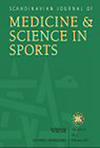Effect of Oral Contraceptive Use on Muscle Hypertrophy Following Strength Training
IF 3.5
2区 医学
Q1 SPORT SCIENCES
引用次数: 0
Abstract
Oral contraceptives (OC) are widely used by women, while their interactions with strength training are yet to be resolved. This study investigated the effects of OC use on muscle hypertrophy and strength adaptation to heavy strength training in young adult women. Fifteen habitual OC users and 17 non‐OC users (NOC) with regular menstrual cycles completed ~12 weeks of strength training, which spanned three menstrual cycles for the NOC group. All participants were young, healthy, and strength‐untrained. Isometric knee‐extensor strength, muscle cross‐sectional area of the vastus lateralis (ultrasound imaging), and body composition (DXA) were used to evaluate training adaptations. Blood samples for estradiol and progesterone analyses, dietary registrations, and questionnaires assessing appetite, vitality, motivation, recovery status, and sleep duration were collected during the intervention period. Both groups experienced gains in lean mass and muscle strength. However, the OC group demonstrated a significantly larger increase in arm lean mass (5.5% ± 3.9% [mean ± standard deviation] vs. 2.9% ± 2.8%,口服避孕药对力量训练后肌肉肥大的影响
口服避孕药(OC)被女性广泛使用,但其与力量训练的相互作用尚未得到解决。本研究调查了使用有氧运动对年轻成年女性肌肉肥大和力量适应大强度力量训练的影响。15名月经周期正常的习惯性OC使用者和17名月经周期正常的非OC使用者(NOC)完成了约12周的力量训练,其中NOC组跨越了三个月经周期。所有的参与者都是年轻、健康、未经力量训练的。采用等长膝关节伸肌力量、股外侧肌横截面积(超声成像)和身体成分(DXA)来评估训练适应性。在干预期间收集血液样本进行雌二醇和黄体酮分析,饮食登记,以及评估食欲、活力、动力、恢复状态和睡眠时间的问卷。两组人的瘦肉质量和肌肉力量都有所增加。然而,OC组表现出更大的臂瘦质量增加(5.5%±3.9%[平均±标准差]vs. 2.9%±2.8%,p <;0.05)和股外侧肌横截面积(10.0%±4.1% vs. 5.3%±4.4%,p <;0.05),与NOC组比较。尽管存在这些差异,但各组在下肢力量增加方面没有显著差异。在整个研究过程中,两组人的食欲、饮食摄入量、活力、运动动机和感觉恢复水平相似,尽管OC组平均每天多睡42分钟。我们的研究结果表明,在力量训练中使用OC可以促进肌肉生长,尽管需要进一步的研究来阐明潜在的机制和长期影响。
本文章由计算机程序翻译,如有差异,请以英文原文为准。
求助全文
约1分钟内获得全文
求助全文
来源期刊
CiteScore
7.90
自引率
4.90%
发文量
162
审稿时长
3 months
期刊介绍:
The Scandinavian Journal of Medicine & Science in Sports is a multidisciplinary journal published 12 times per year under the auspices of the Scandinavian Foundation of Medicine and Science in Sports.
It aims to publish high quality and impactful articles in the fields of orthopaedics, rehabilitation and sports medicine, exercise physiology and biochemistry, biomechanics and motor control, health and disease relating to sport, exercise and physical activity, as well as on the social and behavioural aspects of sport and exercise.

 求助内容:
求助内容: 应助结果提醒方式:
应助结果提醒方式:


